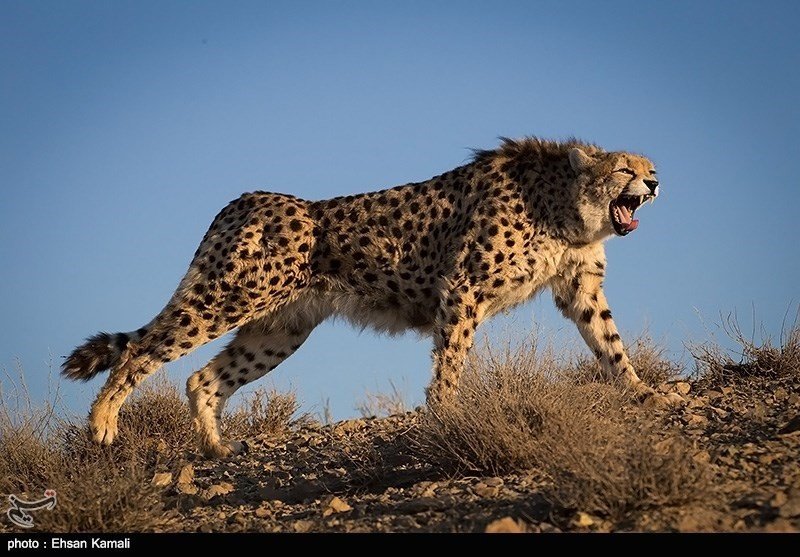DOE builds underpass to avoid Asiatic cheetah road crash death

TEHRAN – In an attempt to provide a safe place for the few surviving Asiatic cheetahs, the Department of Environment (DOE) has constructed an underground passage stretching to 8 kilometers along Abbasabad road in central province of Semnan, Rajab Ali Karegar, the Conservation of the Asiatic Cheetah (CACP) project deputy director has said.
Since past 60 years, Iran is home to the last known population of Asiatic cheetah, which once roamed across vast ranges of west and south Asian countries, from the Middle East to India. Listed as critically endangered by the IUCN, the Asiatic cheetah is among the rarest cats in the world at subspecies level, with fewer than 50 believed to remain in Iran.
In 1370s (1997-2000), according to field studies conducted by both domestic and international experts, a cheetah named Marita, was the only evidence of the cheetahs’ existence for nearly ten years, Karegar stated, adding, the CACP project was launched back in 2001, in cooperation with United Nations Development Program and a number of concerned national and international NGOs to reverse the endangered specie’s drastic decline.
The project has been comprised of three phases aiming at research, protection and training courses for integration of local communities as active partners in protected areas, the first phase was co-funded by the Global Environment Facility and was implemented since 2001 to 2008, while the second phase went into effect in 2010.
The project was implemented on some 5 regions in 6 provinces of the country, through which some 47 cheetahs have been identified since past three years, he added.
Referring to 6 million hectares of Asiatic cheetahs’ habitat in the country, he noted that 60 percent of the cheetahs are inhabiting out of the areas defined to determine the cheetah’s population, so that in the third phase of the project we will not only focus on protected areas supervised by DOE, but also cheetah’s migration corridors will be observed more closely.
He went on to say that through the third phase of the CACP, all the solutions are classified in three fields of strengthening managing methods and optimization, participation of local communities and calling on stakeholders to conserve the precious species.
Given the DOE envisioned building underpasses so that cheetahs can cross beneath highways and avoid road accidents, an eight-kilometer long underground passage has been constructed along Abbasabad road, thanks to various donors, he concluded.
Better conservation plans for Asiatic cheetah conservation, and its prey by training the rangers, increasing the quality of captive breeding, raising public awareness, drawing up plans for alternative jobs for sustainable agriculture, livestock breeding and eco-tourism by soliciting public participation, and decreasing human-wildlife conflict are among the objectives of the third phase of the project.
An environmentalist, Mehdi Nabian said that in order to prevent the species’ extinction, in addition to the DOE, the participation of other related bodies along with national determination is essential.
The cheetah’s habitat is so vast, as many rangers have never seen a cheetah, so it is not easy to capture them alive with the standard conditions and veterinarian present in the area, he lamented.
The DOE’s efforts have come efficient over the past 50 years, and the CACP is the most successful project ever undertaken by the organization, he stated, adding, thanks to the NGOs, even the remote villages in the country are aware of the endangered species and the protection methods through the project.
He went on to note that overfilling of dams, severe soil erosion, heavy rainfall and flash flooding, many environmental issues due to poor environmental policies have posed threats to cheetahs and the country’s biodiversity, so we need all the responsible bodies to join hands on conservation of the world’s fastest mammal confined in Iran.
In December 2018, Hamid Zohrabi, deputy environment chief for DOE’s natural environment and biodiversity directorate said that the DOE has considered using gestational surrogacy as an option to breed the endangered species of Asiatic cheetah, in case artificial insemination and captive breeding face failure.
director of aquatic wildlife and biodiversity office at the DOE, Majid Kharrazian-Moqaddam, said in August 2018 that Cheetahs’ habitats in Iran are stretching over 12 million hectares of land area and over the past 16 years only experts collaborating with the CACP project have actually strived to count 48 cheetahs using trap cameras and other technical methods.
Kharrazian-Moqaddam explained road kill constitute 70 percent of cheetahs’ fatalities, as some 42 Asiatic cheetahs have been killed in the country since past 16 years, 28 of them died in road crashes and 14 other were either killed in conflicts with guard dogs or due to other unknown reasons.
For one Abbasabad-Mayami road, linking north-central Semnan province to Mashhad, northeastern province of Khorasan Razavi, in one of the deadliest roads for Asiatic cheetahs as 8 cheetahs have been killed in this area over the past 10 years, he lamented.
Roads fragmenting cheetahs’ habitats are the main threats for the species, while guard dogs and stray dogs, drought spells, decreasing population of the prey species to support the cheetahs, and habitat loss are also other factors endangering the sparse population of the cheetahs in the country.
FB/MQ/MG
